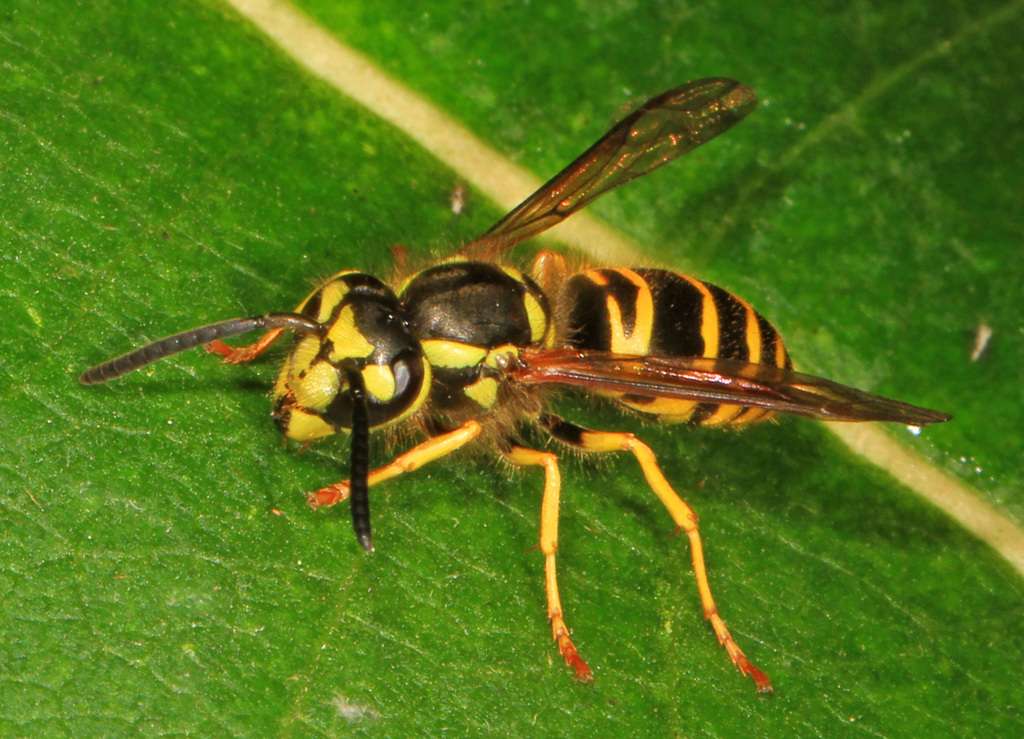Out in the Woods
- September 27th 2024
- Out in the Woods

Yellowjackets Aren’t All Bad (Really)
By Kevin McKeon, Maine Master Naturalist
Yup, yellowjackets sting, their sting hurts, and the reason is clear when you see a magnified picture. Those barbs look menacing but are relatively small — probably an aid in keeping the stinger inserted during venom injections. Some bees will die after a single sting, but these wasps often sting repeatedly.
Yellowjackets are one of more than 100,000 named species of wasps and come from relatives 200 million years old that flew over the supercontinent Pangea with the dinosaurs and Earth’s first birds. In North America, there are 2,900 species of stinging, or predatory, wasps. Bees are in the same taxonomic order as wasps but are vegetarians, eating and feeding their young (larvae) pollen and nectar. Wasps are omnivorous, hunting insects and spiders to feed their larvae, while also eating nectar, sap, and honeydew — a sticky, sugar-rich aphid secretion. Adult yellowjackets also like fruits, meat, and sweet drinks so they’re often visitors to our picnics and park areas.
Because they’re strongly attracted to sugar, yellowjackets often feed on nectar while hunting for insects — helping to manage many agricultural insect pests and pollinating crops. The workers return to the nest to feed the larvae: a chewed-up (masticated) paste of insects and carrion. The larvae secrete a sugary substance that is eaten by the adults — a food exchange called trophallaxis. So, while yellowjackets can be a nuisance, they are quite beneficial and should be left alone when possible.
As cold fall weather approaches, the nest weakens and dies. During this weakened state, weasels, skunks, raccoons, and bears will raid and eat the wasps and larvae.
Of the 2,900 stinging wasp species, only 44 are social nest builders, and two of those are yellowjackets: One species nest below ground, and the other above ground. Social wasps give cooperative care to the nest’s brood while maintaining divisions between reproductive and non-reproductive groups. The colony is comprised of queens, males who live to fertilize the queens, and sterile female workers who assist the queen, feed the young, and defend the nest.
The yellowjacket nest is begun in the spring by a queen, who mated the previous summer/fall and spent the winter in diapause — a form of dormancy similar to hibernation. After awakening, she’ll forage for wood to mix with her saliva, using the paste to form a stalk on a suitable nesting surface. The 1st cell is attached to the stalk, other cells attach to this cell, then she wraps it all in a pulpy envelope. After the queen lays eggs in these early cells, she’ll forage for food, care for the young, and defend the nest. After the initial workers hatch, they maintain and expand the nest while the queen continues to produce more offspring. The inner envelopes are progressively re-chewed to make room for more cells, and the nest thus grows. Underground nest cavities are enlarged by workers carrying excavated soil from the nest area. Some nests reach the size of a basketball if left undisturbed, growing through several seasons and housing multiple queens, over 15,000 cells, and thousands of workers — One huge nest in South Carolina was estimated to hold ¼ million wasps! A nest is deemed to have “matured” when queen cells have been formed. In the Sanford area, this usually happens around September. The colony will die after a hard frost, with some of the mated queens finding shelter for the winter, surviving to the following spring — Then it starts all over again.
Let’s get back to yellowjacket stingers: They’ll grab and hold on with a bite while repeatedly unleashing those venom-laden lances. These gals are very territorial, are the most aggressive of all stinging insects, and responsible for most stings in the U.S. Those stings are painful to everybody, and some folks who happen to be allergic to their venom could face a life-threatening event. Those not allergic could sustain 1,500 stings prior to death. (I wonder who the test subject was for THAT one!) The intense pain comes mostly from an acidic chemical combination of amino acids called wasp kinin, which causes cell breakdown — and the formation of colorful human language!
Stinger close up: https://en.wikipedia.org/wiki/Yellowjacket#/media/File:Vespula_vulgaris_SEM_Sting_01.jpg
Dormancy: https://sanfordspringvalenews.com/sleep-comes-in-many-forms/






